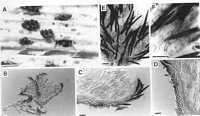|
 Pirottaea mahinapua Pirottaea mahinapua
BiostatusPresent in region - Indigenous. Endemic
Images (click to enlarge)
Caption: Fig. 5 Pirottaea mahinapua (PDD 68334): A, apothecia erumpent from host tissue in groups;
B, apothecium in vertical section; C, upper margin of apothecium in vertical section; < | 
Caption: Fig. 6 Pirottaea mahinapua (PDD 68334): A, asci; B, apex of paraphyses; C, ascospores; D,
setae in surface view. |
Article: Johnston, P.R. (1998). Four new Pirottaea species from New Zealand. New Zealand Journal of Botany 36(4): 645-652 (http://www.rsnz.org/publish/abstracts.php).
Description: Apothecia develop in clusters of 4-10, erumpent from dead leaf tissue of Phormium tenax (Phormiaceae). Individual apothecia separate within the clusters, 0.1-0.2 mm diam., cupulate, sessile, densely clothed with short, black setae; hymenium greyish.
Ectal excipulum 25-30 µm wide in vertical section, comprising several layers of angular to globose cells 5-8 µm diam., with thick walls, mostly hyaline, but outermost 2 or 3 layers of cells with walls pale brown, and with scattered cells with dark brown walls. Excipular cells becoming cylindric near margin of disc, 3-4 µm diam., with ends more or less free and hair-like. Setae arising directly from excipular cells, some from surface of receptacle, others with rooting bases from within the excipulum, and also mixed amongst hair-like cells at margin. Setae 35-65 x 6-8 µm, fusoid, tapering to more or less acute apex, 3 or 4-septate, wall very dark and somewhat thickened, and septa often difficult to see. Hair-like elements also arising from margins of receptacle, 20-30 x 4-5 µm, 2 or 3-septate, with thin, pale brown walls. Medullary excipulum very poorly developed, comprising 3 or 4 rows of long-cylindric cells 2.5-3 µm diam., with thin, hyaline walls.
Paraphyses 2 µm diam., undifferentiated at apex, about same length as the asci. Asci 55-70 x 10-11 µm, cylindric, apex rounded, wall thickened at apex, with small amyloid ring, 8-spored, the spores confined to upper half of ascus. Ascospores 9.5-12 x 4-4.5 µm, elliptic, in side view slightly flattened on one side, hyaline, 0-septate.
Cultures 40-60 mm diam. after 4 weeks, on both OA and MEA thin colonies with
little or no aerial mycelium, olivaceous-grey pigment in reverse on MEA. Cultures remained
sterile.
Notes: ETYMOLOGY: name of the type locality.
NOTES: The excipular structure of P. manihapua is similar to that described for P. senecionis
by Nannfeldt (1985). In addition to the very dark-walled setae both species have numerous
paler, thin-walled hair-like elements arising from the excipulum. The New Zealand species is
distinguished by its larger ascospores, and by developing in clusters of up to 10 apothecia.
P. manihapua differs from the other New Zealand species in the excipular cells being
mostly hyaline to pale brown. Although this is typical for most species in the genus
(Nannfeldt 1985), the other New Zealand species have excipular cells with uniformly
darkened walls.
|